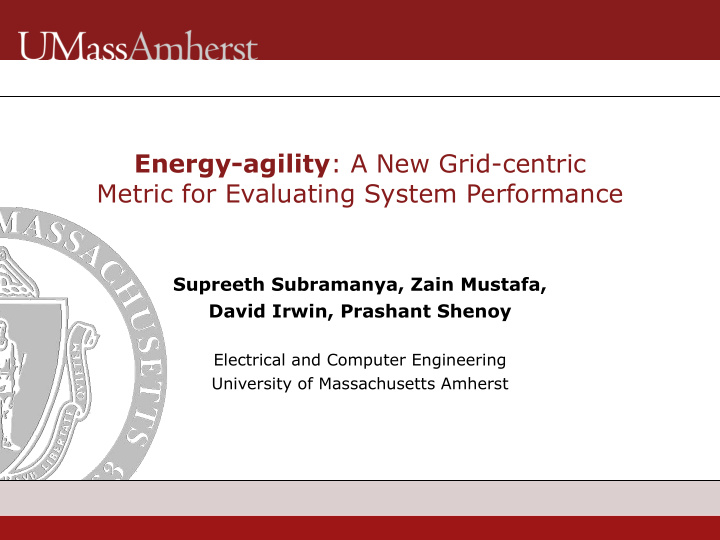



Energy-agility : A New Grid-centric Metric for Evaluating System Performance Supreeth Subramanya, Zain Mustafa, David Irwin, Prashant Shenoy Electrical and Computer Engineering University of Massachusetts Amherst
Rethinking Energy-efficiency (1/4) Energy-efficiency = Work done per joule of energy used Better energy-efficiency Better energy-efficiency —> lower —> systems run longer energy bills, lower carbon footprint UMass Amherst - Electrical and Computer Engineering ‹#›
Rethinking Energy-efficiency (2/4) What is wrong with the datacenter scenario? Misplaced Assumptions! ✗ All energy is created equal ✗ Energy is available at any time Marginal Fuel Cost ($/MWh) Generation Capacity (Gigawatts) UMass Amherst - Electrical and Computer Engineering ‹#›
Rethinking Energy-efficiency (3/4) Why energy-efficiency is not sufficient? Energy Used Energy Available energy Available energy Wasted Renewable-powered datacenter Time (hours) Time (hours) Energy Consumed Less More Finish Time Later Earlier UMass Amherst - Electrical and Computer Engineering ‹#›
Rethinking Energy-efficiency (4/4) How do we evaluate green compute systems? Energy-efficiency ✗ Solely driven by workload ✗ Opaque to energy characteristics Energy-proportionality ✗ Non-standard metric Energy price UMass Amherst - Electrical and Computer Engineering ‹#›
Energy-agility (1/3) Energy-efficiency = Work done per joule of energy consumed by the system Energy-agility = Work done per joule of energy available to the system Formally, Energy-agility = Work done given a power signal P(t) that dictates an energy cap over each interval (t - Ƭ , t] UMass Amherst - Electrical and Computer Engineering ‹#›
Energy-agility (2/3) Salient Characteristics 2. Captures energy characteristics 1. Accounts for energy used and wasted $ Availability Availability Time (hours) Time (hours) 3.Quantifies dynamics between a platform , its workload and its energy Enables a rigorous and Price-independent system evaluation UMass Amherst - Electrical and Computer Engineering ‹#›
Energy-agility (3/3) Design Considerations DVFS / ACPI S-states System Input power signal Energy Storage Platform power states Application vs. vs. ✗ Inter-node coordination Intermittent power changes UMass Amherst - Electrical and Computer Engineering ‹#›
Conclusion Energy-efficient systems are not necessarily “green” Quality/characteristics of energy matter as much as the quantity Current metrics are ineffective for green energy We propose a new metric, energy-agility Enables a rigorous performance evaluation of a green compute system UMass Amherst - Electrical and Computer Engineering ‹#›
Questions Supreeth Subramanya ssubramanya@umass.edu Sustainable Computing Lab (http://sustainablecomputinglab.org/) Thank you! UMass Amherst - Electrical and Computer Engineering ‹#›
Recommend
More recommend